ALP 7.7%
Incumbent MP
John Hyde, since 2001.
Geography
Central Perth. The seat of Perth covers the Perth CBD and areas to the north. The seat covers most of Perth and Vincent local council areas, including the suburbs of West Perth, Mt Hawthorn, North Perth, Leederville, Highgate, Northbridge and parts of East Perth and Mt Lawley.
Redistribution
The seat of Perth gained a small area from Mount Lawley in the Highgate area. The ALP’s margin was reduced from 7.8% to 7.7%.
History
Perth existed as a seat from 1890 to 1950 and again since 1962. The seat has been won by the ALP at every election since 1968, and has only lost the seat at one election since the 1930s.
The seat was won by the Liberal Party’s Peter Durack in 1965. He lost the seat in 1968. He then went on to win a Senate seat in 1970. He served as Attorney-General from 1977 to 1983, and retired in 1993 after losing preselection.
Durack was defeated in 1968 by Terry Burke, son of former federal MP Tom Burke and older brother of Brian Burke. Brian Burke led the ALP to power in 1983, and served as premier until 1988.
Terry Burke held Perth for nineteen years, and resigned in 1987.
The 1987 by-election was won by Ian Alexander. He resigned from the ALP in 1991 during his second term and finished his term as an independent.
Diana Warnock won in 1993, and served two terms until 2001.
Since 2001, Perth has been held by John Hyde.
Candidates
- John Hyde (Labor)
- Eleni Evangel (Liberal)
- Jonathan Hallett (Greens)
- Farida Iqbal (Independent)
- Kevin Host (Australian Christians)
Assessment
Unless there is a large swing to the Liberal Party, Labor should hold on in this seat.
2008 result
| Candidate | Party | Votes | % | Swing |
| John Hyde | ALP | 7,724 | 41.0 | -7.0 |
| Chris Edwards | LIB | 6,907 | 36.7 | +2.8 |
| Jonathan Hallett | GRN | 3,631 | 19.3 | +6.5 |
| Guennadi Moukine | CDP | 576 | 3.1 | +0.5 |
2008 two-candidate-preferred result
| Candidate | Party | Votes | % | Swing |
| John Hyde | ALP | 10,899 | 57.8 | -3.0 |
| Chris Edwards | LIB | 7,937 | 42.2 | +3.0 |
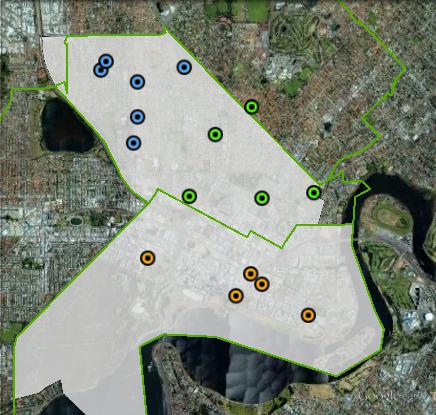
Booth breakdown
Booths have been divided into three parts: north, central and south. Booths in the City of Perth have been grouped as south, with booths in Vincent grouped as north and central.
The ALP polled over 40% of the primary vote and topped the poll in the north and the centre. The Liberal Party polled 48% in the south. The Greens vote varied from 22% in the centre to 14.3% in the south.
| Voter group | ALP % | LIB % | GRN % | Total votes | % of ordinary votes |
| North | 41.19 | 36.87 | 19.32 | 6,140 | 42.57 |
| Central | 45.10 | 29.70 | 22.08 | 5,435 | 37.68 |
| South | 33.99 | 48.35 | 14.29 | 2,848 | 19.75 |
| Other votes | 40.21 | 37.43 | 18.99 | 4,414 |
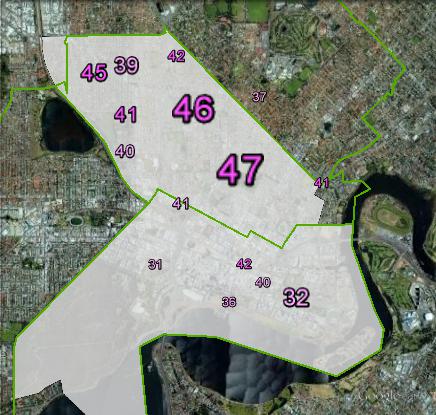
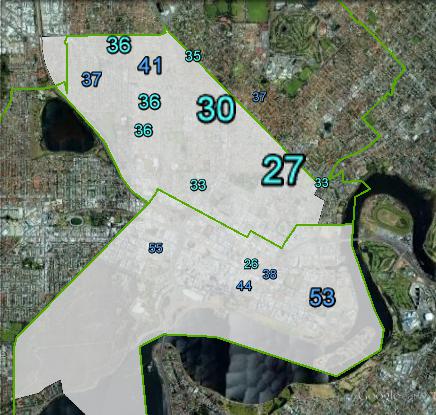
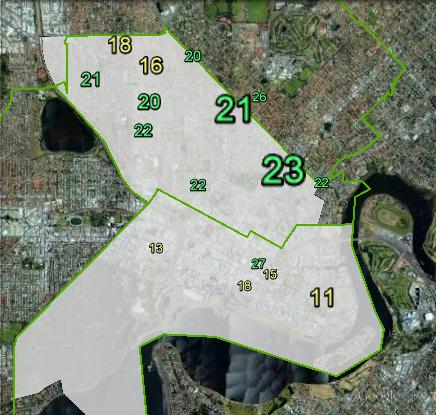


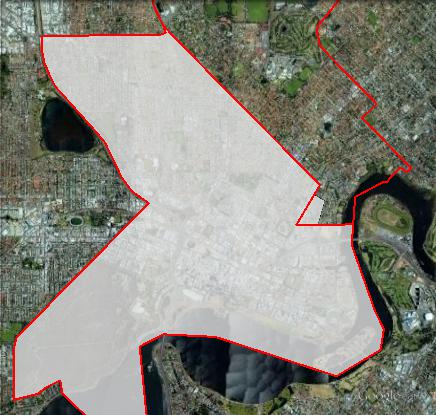
My prediction: Labor retain
My prediction: I will vote at the big Green 23% booth, Highgate Primary. I’ll probably ignore every HTV card, including the party I’ll vote for, and eat something tasty from the local P&C stall.
Ben, if you ever find yourself in this part of the world, gimme a hoy and I’ll give you the William St tour of Northbridge. Places to eat and drink, and John Hyde’s famously colourful office.
More seriously: Eleni Evangel recently got some posters round here from the inexhaustible Liberal poster budget. She shouldn’t’ve bothered, though. She’s been out-postered for six months now, not by Hyde, but by Natasha Cheung (Lib candidate for West Swan). A lot of the Asian shops around here seem to be Liberal-friendly but not Evangel-friendly.
Evangel is a Perth councillor, and she’s been on Channel 31 a few times. Running in the tiny fishbowl of Perth council, she thinks she’s notable. Hyde, meanwhile, was mayor of Vincent, where most people here actually live. (Perth and Vincent, and well as Cambridge and Victoria Park, all used to be part of a much larger City of Perth, before Richard Court abolished it in the 90’s to remove potential Labor voters from any CBD decisions.)
This seems to have had a fairly high turnover of MPs for a safe seat…normally a seat like this is where a party would plonk a long-term future frontbencher to hang around for 20 years.
Anyway, Labor should retain, although it would have been more interesting if WA had OPV….
Ian Alexander was one of a few Labor MP’s who quit the party before Carmen Lawrence’s govt went belly-up in 1993 – it was a messy time for them, after WA Inc. He joined the Greens later on, and ran for them in Freo in 2001.
Prediction: ALP Retain
Although I expect the Liberals to come quite close.
What on earth happened here? I thought John Hyde was a well-respected member.
The media is suggesting that the liberals win is due to inner city issues. I don’t think this is necessarily true as most Perth residents wouldn’t pick the waterfront development as a key issue just because this is located in the electorate. This as well as the museum and closure of riverside drive are greater metro matters and not necessarily local.
I would suggest the defeat of Labor was more attributed to gentrification of inner city areas with development including modern apartments that are only within reach of those who can afford them. I.e. mining etc which the pro-business liberals would support more.
John Hyde is a good member and this result is quite unexpected and demonstrates that inner city areas are not necessarily a given for the Left especially in a well to do State.
The whole “inner city leftist” thing has always sounded a bit odd in WA. We’ve had Greens in parliament for 20 years, but the hot spot of their Perth vote has always been Fremantle, 15 km away. What you’d call the “latte belt” round here would include Leederville, North Perth and Mt Lawley. It’s certainly got a decent Green vote, but never big enough to come anywhere near winning seats like Balmain (NSW) or Melbourne (Vic). A hypothetical seat covering the City of Vincent would’ve come close on 2008 figures… not 2013, though.
I live in Northbridge (the cheap, un-gentrified bit), work in the CBD, and I can’t remember the last time I went anywhere near the Barrack St jetty. There’s not a whole lot down there, and you have to walk across Riverside Drive to get there. I wish the city would stop being a construction site for a few years (between the underground rail and various roadworks on William and Wellington St, it’s been going for a decade now), but there’s been nothing much about the foreshore works that have annoyed me except for its pathetic name.
Another factor which might have played a part is the seat has a very high percentage of Asian residents, pardon me for using such an oversimplified term such as Asian, who in certain Socioeconomics has more in common with general liberal voters then Labor voters. While I am not saying that they have all gone to the liberals, they are more likely to be swing voters in general.
I’ve just had a look at the figures + plugged ’em into the spreadsheet, and what do I see:
Highgate Primary:
ALP 45.9
Lib 35.4
Grn 15.3
SA 1.68
CDP 1.63
Of the regular booths, it was the best for Labor, worst for the Libs, and among the best for the Greens (although still a 9% swing against them), and the god-botherer got put down to last place by the trots (by a single vote). Total left-wing vote = 58.4%. We keep the faith round here, and we’re not gentrified yet. I knew my suburb wasn’t turning blue. 🙂
However, in the Perth / East Perth booths, Labor got whipped badly. It’s still only a quarter of the population, but it’s got seven booths this time… Libs beat ALP (on primaries) by over 10% at six booths, and over 30% at three of them!
(I’ll post a bit more later, I’m number crunching.)
Whoops – make that 62.9% of formal votes to the lefty scum of Highgate. (Forgot to change a column, so that makes it look even better.)
OK, numbers crunched…
There were 17 booths this time compared to 16 last time. Of Ben’s regions, North stayed the same, Central lost one (St Paul’s), and South (ie: Perth council) churned over completely – from 5 polling places up to 7, but only 2 were the same as 2008 (Constitutional Centre and RPH).
Anything on is gonna look like 2013 figures (2008 figures in brackets).
# formal votes:
North: 6323 (6140)
Central: 5452 (5435)
South: 3900 (2848)
Total: 19,913 (18,837)
Or in percentages:
North: 40.34 (42.57)
Central: 34.78 (37.68)
South: 24.88 (19.75)
Votes for ALP / Lib / Grn:
North: 37.8 / 47.2 / 12.7
Central: 42.6 / 40.8 / 13.8
South: 29.7 / 57.7 / 10.2
And the primary vote swings from 2008:
North: -3.4, +10.3, -6.6
Central: -2.5, +11.1, -8.3
South: -3.7, +9.4, -4.1
So: swings were reasonably similar around the seat, with Central (Mt Lawley / North Perth / Northbridge) being worst for the Greens (where they had more to lose). With over 1000 new voters in the south (flats in Perth / East Perth) and only 200 elsewhere, that’s gonna be pushing Perth closer to the Libs even in a good year for Labor if it keeps up like that.
If people think it’s useful, I could do a post-election booth map for Perth and any other seats people are interested in?
It’s interesting that despite what people might think, the Liberals actually hold more state and territory seats than Labor covering capital city CBDs. The Liberals hold the state/territory seats covering the Brisbane, Adelaide, Perth and Darwin CBDs. They are also preferred on a 2PP basis in the state seat of Sydney.
It is really only Melbourne, Hobart (Denison) and Canberra (Molonglo) where the LIberals are not competitive.
Surely that is partly a sign of the Liberal upswing? Most of those seats are actually marginal seats held by Labor recently (Adelaide, Perth, Brisbane, not sure about Darwin).
In the case of Brisbane the seat is likely to return to Labor if the LNP’s massive landslide is reduced in 2015.
Good thinking 99. I’d like to see Perth, Freo, Kimberley, and Collie-Preston (to see if my theory about former parts of Capel becoming relatively more Labor-friendly than former parts of Collie-Wellington was correct).